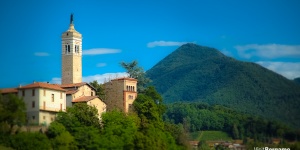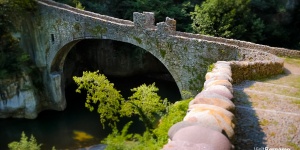Bergamo’s province, and especially the territory of Lemine, holds a collection of masterpieces of the Romanesque architecture built between the 11th and 12th century. These places express the power of a simple and durable art and cast our mind back to the time of pilgrims, Gregorian chants, imaginary animals and demonic figures that reproduce the conflict between good and evil, encouraging reflection and learning, contemplation of human expertise, immersion in a kind of light that is earthly and yet inspired by faith.
Bergamo’s province, and especially the territory of Lemine, holds a collection of masterpieces of the Romanesque architecture built between the 11th and 12th century. These places express the power of a simple and durable art and cast our mind back to the time of pilgrims, Gregorian chants, imaginary animals and demonic figures that reproduce the conflict between good and evil, encouraging reflection and learning, contemplation of human expertise, immersion in a kind of light that is earthly and yet inspired by faith.

Begin your visit with the Rotonda di San Tomè. The name Rotonda (rotunda) derives from its circular plan, a very unusual feature for religious buildings. Its is located in a secluded place, amid fields, maybe because it was originally built over an ancient necropolis, near river Brembo. The reason for this kind of plan should be traced back to the Medieval habit of imitating the rotunda of the Church of the Holy Sepulchre in Jerusalem, where Jesus is said to have been buried. The Rotonda di San Tomè is made of rough stone and is divided in three sections: the nave, the crossing tower and the lantern. The little light coming from its tiny windows heighten the reflective atmosphere of the church. The capitals, all different from one another, with decorations inspired by nature and allegories, are remarkable. Once there was a small monastery next to San Tomè, later turned into a farmstead. The building had been rehabilitated thanks to a clever restoration project and it has now been reconverted in a research centre – Antenna Europea del Romanico – where conferences, exhibitions and events are held.
Begin your visit with the Rotonda di San Tomè. The name Rotonda (rotunda) derives from its circular plan, a very unusual feature for religious buildings. Its is located in a secluded place, amid fields, maybe because it was originally built over an ancient necropolis, near river Brembo. The reason for this kind of plan should be traced back to the Medieval habit of imitating the rotunda of the Church of the Holy Sepulchre in Jerusalem, where Jesus is said to have been buried. The Rotonda di San Tomè is made of rough stone and is divided in three sections: the nave, the crossing tower and the lantern. The little light coming from its tiny windows heighten the reflective atmosphere of the church. The capitals, all different from one another, with decorations inspired by nature and allegories, are remarkable. Once there was a small monastery next to San Tomè, later turned into a farmstead. The building had been rehabilitated thanks to a clever restoration project and it has now been reconverted in a research centre – Antenna Europea del Romanico – where conferences, exhibitions and events are held.

The church of San Giorgio is not far from San Tomè and shares with the Rotonda its plain exterior. The façade of the church is covered with sandstone ashlars on the lower side and blocks of white stone on the upper side. The apse is divided in five sections surrounded by tiny columns resting on pilaster strips connected by arches.
The church has a nave and two aisles and contains frescos painted in different periods, starting from the 13th century. Some of them have folk traits, while others are more elegant, since the painters were more mindful of their works of art. In the upper side we find the Stories of Christ, and below these, a striking representation of Saint George on horseback killing the dragon.
The church of San Giorgio is not far from San Tomè and shares with the Rotonda its plain exterior. The façade of the church is covered with sandstone ashlars on the lower side and blocks of white stone on the upper side. The apse is divided in five sections surrounded by tiny columns resting on pilaster strips connected by arches.
The church has a nave and two aisles and contains frescos painted in different periods, starting from the 13th century. Some of them have folk traits, while others are more elegant, since the painters were more mindful of their works of art. In the upper side we find the Stories of Christ, and below these, a striking representation of Saint George on horseback killing the dragon.

Previously standing alone in the fields, this solidly constructed church preserves a splendid cycle of frescoes dating back to the twelfth and thirteenth centuries, one of which depicts the great St. George on his white horse.
These frescoes are considered the most important example of medieval painting in the Bergamo area.

The historic building complex “of the Madonna” had been erected over an ancient castle, on a cliff dropping sheer to the river Brembo. The main building of the complex is a 16th century church overlooking the plain.
Next to the church stands the ancient parish church of San Salvatore, dating back to the 8th century, one of the most well-preserved example of pre-Romanesque architecture in the territory of Bergamo. The church houses a masterpiece dating back to 1130, an ambo constructed over the vault of the staircase leading to the crypt. The crypt, accessible from two side staircases, is the most ancient crypt of Bergamo’s province and preserves the atmosphere of the ancient places of worship. Its rectangular plan is divided in four columns whose capitals probably come from a pre-existing Roman building.
The historic building complex “of the Madonna” had been erected over an ancient castle, on a cliff dropping sheer to the river Brembo. The main building of the complex is a 16th century church overlooking the plain.
Next to the church stands the ancient parish church of San Salvatore, dating back to the 8th century, one of the most well-preserved example of pre-Romanesque architecture in the territory of Bergamo. The church houses a masterpiece dating back to 1130, an ambo constructed over the vault of the staircase leading to the crypt. The crypt, accessible from two side staircases, is the most ancient crypt of Bergamo’s province and preserves the atmosphere of the ancient places of worship. Its rectangular plan is divided in four columns whose capitals probably come from a pre-existing Roman building.

Built vertically on the river Brembo where once there was a very ancient castle, the church (XVI century) dominates a wide landscape and is close to the ancient parish church of San Salvatore (VII century), one of the best preserved examples of Bergamo's Pre-Romanesque.
By means of two little side staircases you can get to the crypt, the most ancient one in the province, which still has the atmosphere of the ancient religious places.
It's rectangular, divided transversely by four columns with capitals maybe partly rescued from a pre-existent Roman building. Inside you can see frescoes datable from the X to the XVI century and a sandstone ambo of the XII century.

Archaeological finds show that in 1000 B.C., as well as in Roman times, the area was already settled. In the early Middle Ages the area adjacent to Clanezzo became crucial and thronging since it had become an obligatory place of transit. Around 1000 AD, count Attone Leuco ordered the construction of the castle and of a bridge over stream Imagna, next to the point where the stream meets river Brembo.
The stone bridge, consisting of a single arch, is still open and it is an outstanding example of Medieval architecture. Walking along this path, surrounded by vegetation and with the sound of the river running, is a truly enchanting experience. Not far from the ancient bridge there is now a new wooden and iron bridge that, with its moving structure, swings at each step.
Archaeological finds show that in 1000 B.C., as well as in Roman times, the area was already settled. In the early Middle Ages the area adjacent to Clanezzo became crucial and thronging since it had become an obligatory place of transit. Around 1000 AD, count Attone Leuco ordered the construction of the castle and of a bridge over stream Imagna, next to the point where the stream meets river Brembo.
The stone bridge, consisting of a single arch, is still open and it is an outstanding example of Medieval architecture. Walking along this path, surrounded by vegetation and with the sound of the river running, is a truly enchanting experience. Not far from the ancient bridge there is now a new wooden and iron bridge that, with its moving structure, swings at each step.

Visitors to Ubiale, a small cluster of houses at the entrance to the Brembana Valley, often feel like they have stepped back into the Middle Ages.
One interesting example of these is the elegant bridge built by Count Attone over the River Imagna at the point where it flows into the River Brembo.
Count Attone, the last count of Lecco and Almeno, was credited not only with the design of the bridge but also the construction of Clanezzo Castle and a fortification on Mount Ubione which controlled access to the Imagna Valley.
Certain important parts of the castle survive today, including a tower. The strategic importance of the area is confirmed by the fact that a mule path ran down to the River Brembo to the place where a ferry once connected the two banks. Here, in 1925, a suspension bridge was built for workers to cross to the factories where they worked. The bridge is still in use today.
A short distance from Ubiale, at the mouth of the River Imagna, the remains of a magnificent water hammer can be found. This hammer worked iron and remained in operation until half a century ago. Although deserted, the place is extremely interesting.